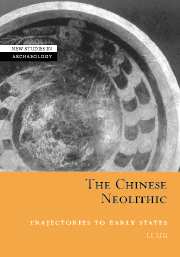Book contents
- Frontmatter
- Contents
- List of illustrations
- List of tables
- Preface
- Cambridge Cultural Social Studies
- 1 Setting the scene
- 2 The changing environmental contexts of China's first complex societies
- 3 Household subsistence and ritual
- 4 Spatial organization and social relations in communities
- 5 Community burial patterns
- 6 Development and decline of complex societies in the Central Plains
- 7 Development and decline of social complexity beyond the Central Plains
- 8 Trajectories toward early states
- 9 Reconstructing social processes
- Notes
- Appendixes
- References
- Index
2 - The changing environmental contexts of China's first complex societies
Published online by Cambridge University Press: 22 September 2009
- Frontmatter
- Contents
- List of illustrations
- List of tables
- Preface
- Cambridge Cultural Social Studies
- 1 Setting the scene
- 2 The changing environmental contexts of China's first complex societies
- 3 Household subsistence and ritual
- 4 Spatial organization and social relations in communities
- 5 Community burial patterns
- 6 Development and decline of complex societies in the Central Plains
- 7 Development and decline of social complexity beyond the Central Plains
- 8 Trajectories toward early states
- 9 Reconstructing social processes
- Notes
- Appendixes
- References
- Index
Summary
During the reign of Yao, the world was disorderly, and the land under the heaven was inundated by floods.
“Tengwengong” in Mencius, a collection of the sayings of Mencius in the fourth century BCThe region of the middle and lower Yellow River valley is characterized by various geographic features, and has witnessed constant climatic and geomorphic change through time. These environmental conditions have in many ways affected economic adaptations and social organizations. Increasing temperature and humidity would have encouraged agricultural activities, mainly millet cultivation, spreading toward the north, and allowed a larger scale of rice cultivation in the Yellow River region. Decreasing rainfall and temperature, on the other hand, would have forced a return to millet, a southward retreat of the agricultural zone, and the development of pastoralism in the north. These environmental changes have had a major impact on the hydrology of river systems (Quine et al. 1999; Ren and Zhu 1994). In warm–moist climatic episodes the heavier vegetation cover would have stabilized the landscape, resulting in rivers with steady flow, a light sediment load, less alluvial build-up and soil formation. In colder–drier climatic episodes the reduction in vegetation cover would have led to more soil erosion, heavier sediment loads, and a flash flood regime in river systems. Human land use also had a major impact on the environment.
- Type
- Chapter
- Information
- The Chinese NeolithicTrajectories to Early States, pp. 19 - 32Publisher: Cambridge University PressPrint publication year: 2005



